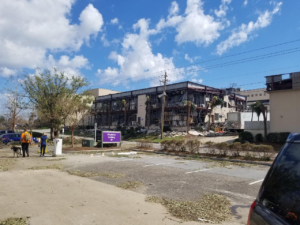Evacuate or shelter in place? The challenges faced by healthcare facilities in the path of hurricanes
Healthcare facilities in the paths of hurricanes have a unique challenge: balancing patient and staff safety with the need to stay operational to deal with ongoing emergencies during and after the storm.
For Hurricane Michael, which made landfall in the Florida Panhandle on October 10, over 30 healthcare facilities including hospitals and nursing homes had to be evacuated.
Of the eight Florida hospitals that evacuated patients in the wake of Michael, five remained open to receive patients for emergency services. Patients in these hospitals were transferred to other nearby facilities.
Gulf Coast Regional Medical Center decided post-storm to evacuate its approximately 130 patients due to “infrastructure challenges” in its community, announcing in a public statement, “Until we can be certain of stable public power, water, and sewage systems, our patients will be safest in our sister hospitals in a neighboring community that was not as severely impacted by the hurricane.”
Likewise, Bay Medical Center Sacred Heart hospital decided to evacuate its approximately 200 patients after an exterior wall cracked, causing a roof to collapse.

Agency for Health Care Administration Secretary Justin Senior told the News Service of Florida that the majority of evacuees were residents of nursing homes. Florida state and local officials have been careful to evacuate elderly residents following an incident last year when 12 elderly residents died from heat exposure after their nursing home lost air conditioning due to power outages from Hurricane Irma. Although this year there was extra caution, nursing homes already tend to err on the side of caution when deciding whether or not to evacuate. The practicing and refining of emergency protocol in nursing homes has been standard since Hurricane Katrina, during which 35 residents of a nursing home died when the home failed to evacuate.
Some health facilities are not able to evacuate all of their patients. In some cases, transporting patients to other facilities may be riskier than sheltering in place. Roper Hospital in Charleston, South Carolina applied for and received an exemption to the mandatory evacuation order during Hurricane Florence because of concern for vulnerable patients, such as those recovering from recent heart or brain surgery. Regarding these types of vulnerable patients, Dede Carey, the clinical manager of the cardiovascular intensive care unit said, “They need to be in a stable environment and have all of the resources available to them in case an untoward event occurs.”
Hospitals are required by law to drill and prepare for any disaster by maintaining extra staff, supplies, and fuel. As protectors of public health, it is necessary for health facilities to have contingency plans to maintain critical functions. As Dr. Amir Haghighat of Bay Medical Sacred Heart in Florida said to CNN about his experience caring for patients during Hurricane Michael, “It was scary, but we had a plan in place.”
Sources and Further Readings
Michael Forces Hospital, Nursing Home Evacuations – WLRN News Service of Florida
Eight hospitals evacuate patients in wake of Hurricane Michael – Modern Healthcare
Hurricane Resources – Gulf Coast Regional Medical Center
Hurricane Michael Forces Florida Hospitals to Evacuate – Huffington Post
Hurricane Florence Evacuation Orders Come With Tough Choices For Medical Facilities – Huffington Post
